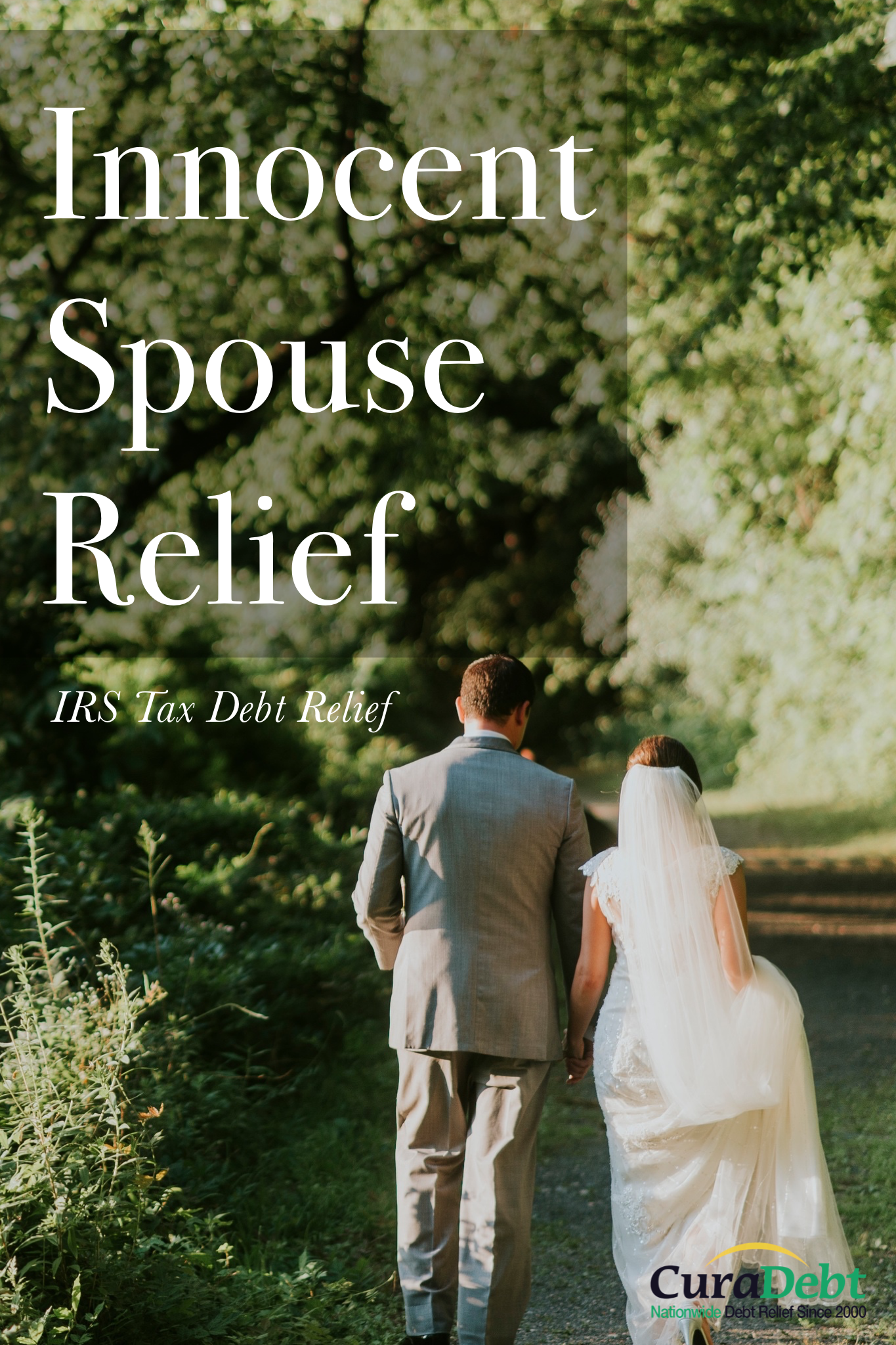IRS Innocent Spouse Relief
IRS Innocent Spouse Relief

Innocent spouse relief can subdue a married or divorced taxpayer of responsibility for paying tax, interest, and penalties arising from additional tax assessments related to ‘married filing joint’ tax returns. The IRS receives tens-of-thousands of innocent-spouse applications a year, and grants fewer than half of them; largely due to the complexities involved in successfully demonstrating to the IRS that the taxpayer’s claim should be approved.
Despite high divorce rates in the United States, most married couples file their tax return as ‘married filing joint’. There are additional tax benefits available to married couples to file jointly, primarily when it comes to families with children, those having education-related costs, or expenses great enough to allow for itemizing on IRS form Schedule A. Many tax deductions and credits are sacrificed if the couple chooses to prepare ‘Married Filing Separate’ tax returns; the only other alternative available to them as a married couple.
Once a married couple files a joint tax return, both are fully liable for what’s on the return; each spouse is jointly and individually responsible for any tax, interest, and penalties and the IRS can collect any amounts due from either spouse, even if just one spouse is responsible for an understatement of tax.
Obtaining innocent-spouse relief is difficult.

In addition to the underlying factor, the ‘Married Filing Joint’ tax return, there are other facts to consider before filing a claim for Innocent Spouse Relief.
An understatement of tax is also required in order to advance a claim for Innocent Spouse Relief. What that means is that whatever tax is reflected on the original Married Filing Joint tax return filed with the IRS, signed by both spouses, is usually ineligible for claims of relief. There must be a new assessment of tax after the original return has been filed. A new assessment arises from something that was overlooked, intentionally omitted, or discovered by the IRS. There must be new taxes, interest and penalties that one spouse believes they should be relieved of responsibility for paying. Critical for the spouse making the claim is, can they show that they didn’t know, or especially, had no reason to know about the erroneous item creating the new liability.
As a married couple, it can be difficult to prove one spouse was unaware of the financial activities of the other; although it happens regularly. Many issues relating to claims for Innocent Spouse Relief arise after divorce relating to tax years during which the taxpayers were still married. As the IRS sifts through the facts and circumstances related to claims for relief, many factors are considered:
- Taxpayers’ education and business background.
- Would a reasonable person in similar circumstances have known of the understated tax?
- The extent of your participation in the activity that resulted in the erroneous item.
- Frequently the spouse of a self-employed taxpayer has working knowledge of the other spouse’s business activities.
- Financial situation as/while a married couple.
- Did the claiming spouse enjoy significant economic benefits because taxes weren’t paid?
- The nature of the erroneous item and the amount of the erroneous item relative to other items.
- Did the erroneous item represented a departure from a recurring pattern reflected in prior years’ returns?
- Whether the claiming taxpayer has been the victim of spousal abuse.
- The IRS will want to know whether the claimant failed to ask, at or before the time the return was signed, about items on the return or omitted from the return that a reasonable person would question (spousal abuse is often cited as a cause for not making reasonable inquiries).
The points above are not exhaustive by any means, and highlight the importance of seeking assistance from professionals with expertise in evaluating and filing claims for Innocent Spouse Relief with the IRS.
If the IRS proves that at the time a spouse signed the joint return, the taxpayer had actual knowledge, or should have reasonably known of any erroneous items giving rise to a deficiency allocable to the other spouse (or former spouse), Innocent Spouse Relief will not apply to any part of the understated tax due to ‘reasonable knowledge’ by the claimant. For this reason, it is wise to have someone with expertise speaking on your behalf with the IRS. Simply saying the wrong thing can drastically alter the outcome of an innocent spouse claim for relief.
Since the IRS will reject a claim for relief if it believes the spouse benefited from the tax avoidance, a trained expert can help demonstrate that despite best efforts to ensure the joint income tax return was correct, it would be unfair to hold the spouse filing a claim liable for the understated tax; deception by the other spouse or being tricked into signing the return are common arguments due to the fact one spouse often handles the finances, prepares the income tax return, and the other just signs it.
While partial relief may still be available to the spouse filing the claim, requesting relief is definitely a situation where you want someone on your side when communicating with IRS personnel. If the spouse filing the claim cannot get relief from all of a liability, relief from some of the liability may be the best available outcome. At the very least, partial relief from liability may well be part of an overall strategy for resolving the entire dispute. Working alone, the spouse likely has no strategy other than wanting the debt to go away. With experts in your corner many aspects of the tax code can be layered in securing a desired outcome for resolving a tax problem.
Other Options
If a taxpayer does not meet all of the requirements for Innocent Spouse Relief, the claiming spouse may potentially benefit from other forms of relief such as:
- Relief by Separation of Liability: where the understated tax (plus interest and penalties) is allocated between the spouses and each is responsible for only a portion of the overall liability.
- Equitable Relief: If you meet all the conditions (and there are many, none listed here), the IRS will grant equitable relief if you establish that it would be unfair to hold you liable for the understated or unpaid tax. This is definitely an area where expertise can be crucial.
- Offer in Compromise and other IRS collection alternatives: again, since any form of IRS tax debt relief is highly fact-dependent, it is probably best to not go-it-alone when seeking relief from liability for IRS debts.
Taxpayers should keep in mind that there are time limits for both the IRS to collect on debts and also for when to file for relief from liabilities. In the case of Innocent Spouse Relief, the proper IRS form (Form 8857 – Request for Innocent Spouse Relief) must be filed within 2 years two years after the date on which the IRS first attempted to collect the tax. While there are exceptions, waiting too long will definitely be detrimental to the spouse seeking claim for relief.
Experience Matters
Another detriment to successfully navigating the IRS in seeking any type of relief from liabilities is seeking the wrong type of help. While knowing exactly who to turn to may be difficult, look to those with a documented history of experience and a proven methodology. CuraDebt, as an example, employs three distinct steps to success in resolving any IRS issue:
Investigation: a rigorous analysis to identify current and projected financials, penalty abatement qualifications should be checked, and the statute of limitations on collection of tax debts should be evaluated. The facts and circumstance pertaining to the claim of Innocent Spouse Relief should be thoroughly examined and documented.
Compliance: once all potential avenues of resolving the tax matter have been identified, IRS compliance is mandatory in order to move any solution forward, especially Innocent Spouse Relief. All past, and even future, tax filing requirements must be fulfilled to the satisfaction of the IRS; experts know this and should be able to easily communicate what is involved.
Resolution: the proper steps in the proper order of any recommended solution can then be executed and put in place to resolve the tax issue, whether it be Innocent Spouse Relief, or any of the other many tax debt issues taxpayers can find themselves caught up in.
In the end…
Sometimes, the success or failure of filing a claim for Innocent Spouse Relief ends up in the U.S. Tax Court; other times, streamlined determinations are utilized, especially if the innocent spouse suffers economic hardship for the IRS action. Every Innocent Spouse claim must be evaluated on the unique facts of each request, and like most IRS tax debt issues, the outcome can have more than one resolution.
As with all IRS tax debts and tax resolution matters, the taxpayers are urged to move forward with expertise. The taxpayer may have only one ‘bite at the apple’ and should avail themselves to a free consultation, such as that offered by CuraDebt, with tax professionals evaluating your case. Call 877-999-0486 today.

